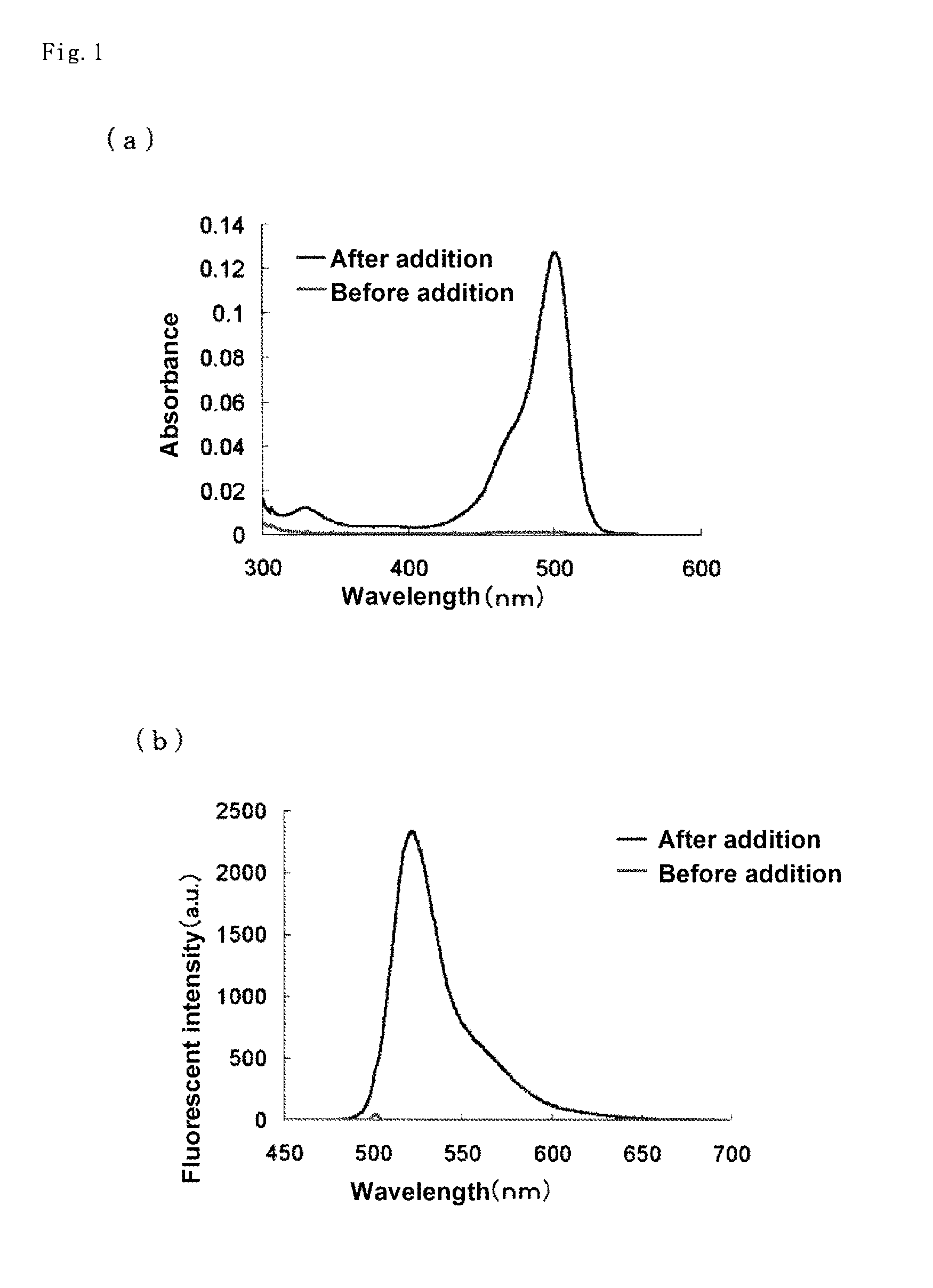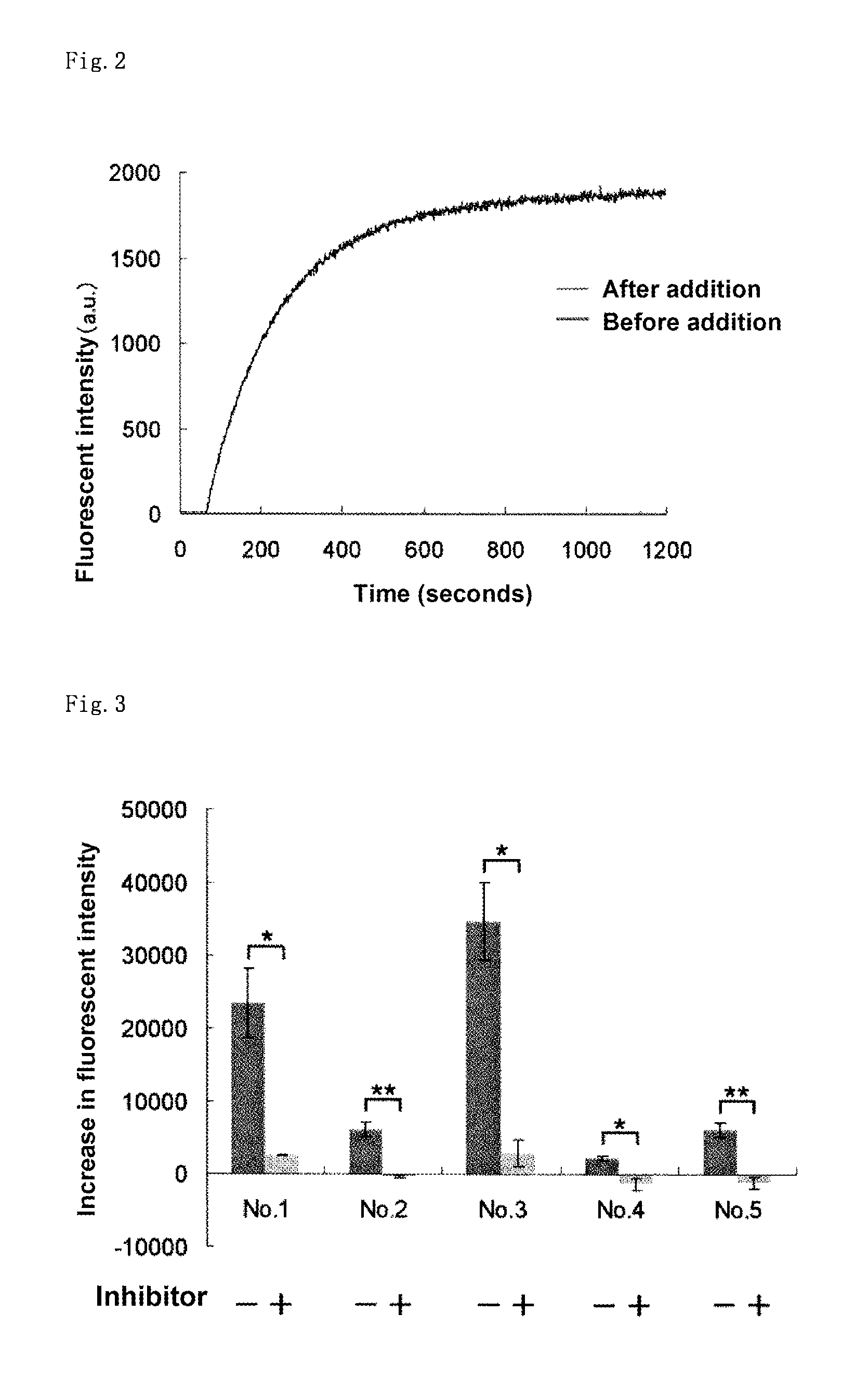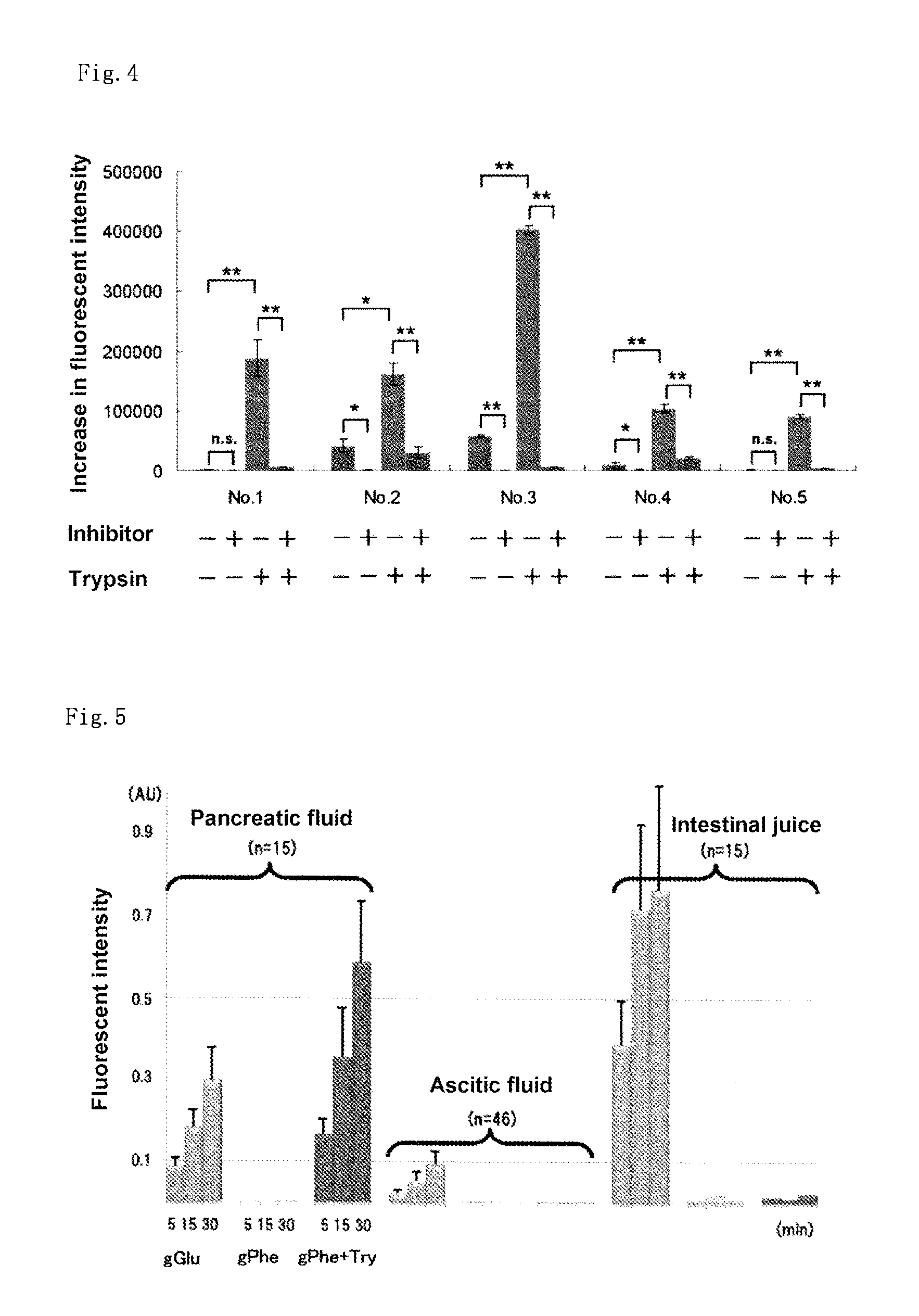Fluorescent probe for high-sensitivity pancreatic fluid detection, and method for detecting pancreatic fluid
a pancreatic fluid and fluorescence probe technology, applied in the field of fluorescence probe for pancreatic fluid detection, can solve the problems of fewer effective treatment methods, mortality rate after surgery reaches several percent, and mortality rate is further increased, so as to prevent the occurrence of pancreatic fluid leakage, high detection accuracy, and quick and high-sensitivity detection
- Summary
- Abstract
- Description
- Claims
- Application Information
AI Technical Summary
Benefits of technology
Problems solved by technology
Method used
Image
Examples
example 1
[0084]According to the following scheme, gPhe-HMRG (glutamyl-phenylalanine hydroxymethyl rhodamine green), which is a fluorescent probe of the invention, was synthesized.
[0085]
(a) Synthesis of Compound 1
[0086]55 mg of HMRG (0.174 mmol, 1 eq.) and 53.6 μL of triethylamine (0.167 mmol, 2.2 eq.) were dissolved in 2 mL of dimethylformamide (DMF), and the resulting mixture was stirred at 0° C. under an argon atmosphere for 10 minutes. Subsequently, 0.5 mL of DMF in which 67 mg of 9-fluorenylmethyl chloroformate (0.261 mmol, 1.5 eq.) had been dissolved was added thereto, and the mixture was stirred for 15 hours. The reaction solvent was removed under reduced pressure, and the residue was purified by silica gel chromatography (dichloromethane / methanol=95 / 5), thereby obtaining an objective compound (36 mg, 22%). In addition, see (a) of Example 2 for synthesis of HMRG.
[0087]1H NMR (400 MHz, CD3OD): δ 7.78 (d, 2H, J=8.1 Hz), 7.61 (d, 2H, J=7.3 Hz), 7.44-7.32 (m, 4H), 6.89-6.87 (m, 3H), 6.74-6...
example 2
[0093]According to the following scheme, gGlu-HMRG (γ-glutamyl hydroxymethyl rhodamine green), which is a fluorescent probe of the invention, was synthesized.
[0094]
(a) Synthesis of Compound 3 (HMRG)
[0095]285 mg of rhodamine 110 (0.8 mmol, 1 eq.) was dissolved in 10 mL of methanol, followed by addition of sulfuric acid, and the resulting mixture was stirred at 80° C. under an argon atmosphere for 10 hours. The reaction solvent was removed under reduced pressure, and the residue was washed with saturated sodium bicarbonate water and water. The resulting solid was dissolved in 10 mL of tetrahydrofuran (THF), 400 μL of a 5M sodium methoxide solution (in methanol) (0.8 mmol, 1 eq.) was added thereto at 0° C. under an argon atmosphere, and the resulting mixture was stirred for 10 minutes. Subsequently, 333 mg of lithium aluminum hydride (8 mmol, 10 eq.) was added thereto, and the mixture was stirred for 3 hours. 5 mL of a saturated ammonium chloride aqueous solution was added thereto, the...
example 3
[0099]According to the following scheme, Bz-Tyr-HMRG (benzoyltyrosine hydroxymethyl rhodamine green), which is a fluorescent probe of the invention, was synthesized.
[0100]
(a) Synthesis of Compound 4 (Bz-Tyr(Ac)—OH, N-benzoyl-O-acetyl-tyrosine)
[0101]263 mg of sodium hydroxide (6.56 mmol) was dissolved in 1.75 mL of water. 500 mg of Bz-Tyr-OH (1.75 mmol) was added to the sodium hydroxide aqueous solution, and dissolved therein, and several pieces of ice were added thereto to thereby cool the solution to 0° C. 620 μL of acetic anhydride (6.56 mmol) was added thereto, and the mixture was stirred at 0° C. for 20 minutes. Then, 20 mL of ethyl acetate and 50 mL of water were added thereto, and the pH was adjusted to 2 with 3M hydrochloric acid. The organic layer was separated, and 20 mL of ethyl acetate was again added thereto, followed by liquid separation. Then, the organic layers were combined, and were dried with sodium sulfate. The ethyl acetate was removed under reduced pressure, and...
PUM
| Property | Measurement | Unit |
|---|---|---|
| fluorescence wavelength | aaaaa | aaaaa |
| fluorescence wavelength | aaaaa | aaaaa |
| wavelength | aaaaa | aaaaa |
Abstract
Description
Claims
Application Information
 Login to View More
Login to View More - R&D
- Intellectual Property
- Life Sciences
- Materials
- Tech Scout
- Unparalleled Data Quality
- Higher Quality Content
- 60% Fewer Hallucinations
Browse by: Latest US Patents, China's latest patents, Technical Efficacy Thesaurus, Application Domain, Technology Topic, Popular Technical Reports.
© 2025 PatSnap. All rights reserved.Legal|Privacy policy|Modern Slavery Act Transparency Statement|Sitemap|About US| Contact US: help@patsnap.com



